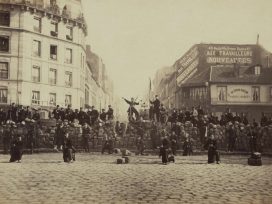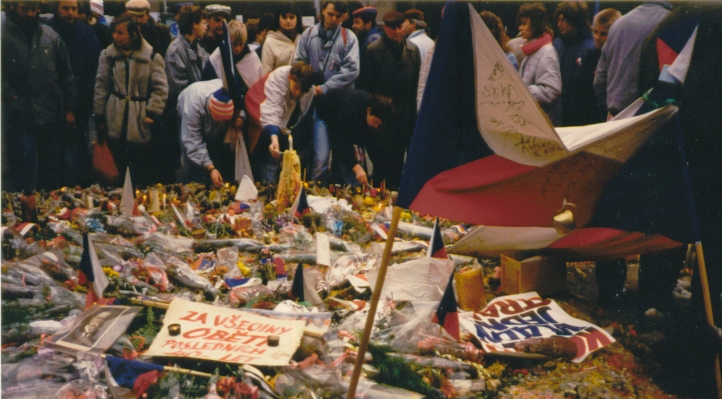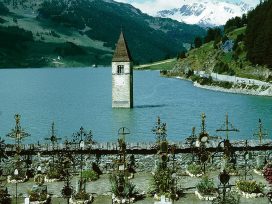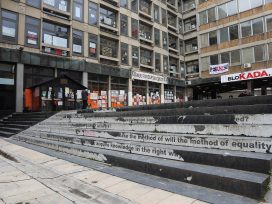‘The sacred is not a great something that you bow down to, but what determines your values, what you would take a stand for.’
Starhawk
‘Politics is that dimension of social life, in which things become true if enough people believe in them.’
David Graeber
Thousands of people have brought candles. Mounds of melted wax cover the cobblestones, marking a spot in Prague’s Wenceslas Square. Despite it being a crime to demonstrate, people gather here. They come to light a candle in honor of an act of defiance against the communist regime that took place 20 years previously.
We are at the spot where on 16 January 1969, the twenty year old history student Jan Palach set himself alight in protest at the crushing of the Prague Spring by Soviet tanks the previous summer. The spot where he poured petrol onto his young body and lit a match, became a place of pilgrimage for dissidents to the Soviet regime. But in January 1989, on the twentieth anniversary of his death, this popular altar to resistance became a spark for the growing powder keg of anti-communist sentiments. When 2,000 people gathered there, they were attacked by police dogs and water cannons. It was the opening act of the Velvet Revolution that erupted in force in November and toppled the regime in 11 days.
In 1989 I was a 24-year-old fine art student. A photo of the candles and wax, transforming a banal piece of the city space into a special sacred place, had a powerful effect on me. A human sacrifice for freedom was followed by mass rituals of grief which led to an uprising. There was something so simple, archetypal and beautiful about it.
As a young artist I was doing body art performances, ritualistic acts involving my body. I would cut my skin, lie in oil covered water for days, insert fishing hooks into my body.
The story of the wax monument brought together all the things I was interested in: ritual, public art and performative protest. And yet it was not artists or shamans doing it, not ‘special’ people, but ordinary folk, doing something extraordinary. One of my teachers at the time, Joseph Beuys, had claimed that ‘everyone is an artist’. A later teacher and comrade, the eco-feminist, activist, witch Starhawk, thinks that magic should never be monopolized by experts: ‘Everyone can do the life-changing, world-renewing work of magic,’ she says, ‘the art of changing consciousness at will.’
In a context where ‘protest’ was banned, the everyday act of ritual grief by people, who did not necessarily ‘look’ like protesters, was a demonstration in disguise. Perhaps less dangerous than frontal defiance, it put the authorities in a dilemma, which is always a powerful resistance tactic. If the authorities repress people doing a ritual with candles, it exposes their irrational violence. If the government lets it happen, it might empower people to dissent more. Either way the authorities lose.
Jungian psychoanalyst Lugi Zoja claims that rituals are an ‘archetypal necessity’ for humans, and ethologists are increasingly showing us that many animals engage in them too. Ritual is the theatre of magic: transformation through communication. Magic because they operate by following the belief that reality can be shaped depending on what we give our attention to. Magic because they help us focus our intentions, despite the toxic dispersal mechanisms of capitalism. They remind us what is sacred. Theatre because they have dramaturgy, scenography, masks and costumes. Theatre because it’s all about bodies moving and opening up the senses. Ritual reminds us of what is sacred, and that we want to defend.
In ritual, we recreate our ties to each other. We are reminded what true freedom is: a paradigm shift from the isolating, disconnected free electrons of the I, able to do what it wishes, promised by capitalism. Rather, ours is an embodied freedom, where communities of humans and more-than-humans are nested, entangled and tied up with each other. Without our relationships to our food and friends, air and water, land and lovers, we are not free to flourish at all. We are not only embedded in relationships; our very identities are created through relationships. Rituals help sustain these reciprocal relationships, they mark and enable change and yet frame the continuity of life, with its repetitions and cycles – they are balancing acts. Most importantly they give gratitude and remind us what it means to be part of an entangled community of living beings.
Already in 1989, I knew that there was way more potential in the power of art and ritual than was possible in what art critic Suzy Gablik called ‘the prisons of the art world’. Four years later I would desert the art world and find myself putting my body in the way of the bulldozers, trying to stop the building of motorways planned to destroy human and more than human communities across the UK. My body was no longer a metaphor but a tool of civil disobedience. This was a performance that was making a concrete difference and I was no longer doing it alone but with thousands of other rebels. I never looked back.
Thirty years later, I am writing from my home, a yurt, on 1,650 hectares of forest, fields and wetlands, that if tens of thousands of people had not put their disobedient bodies in the way, would have become the runway of the Airport of Notre-dame-des-Landes. The zad (zone à défendre) is a territory that transformed me deeply. The more we inhabited this place, the more it inhabited us. The more we fought for it, the more we fell in love with it.
Ritual disguised as a demonstration
The struggle against the airport of Notre-Dame-des-Landes lasted over forty years, beginning in the 1970s when farmers refused to let the state expropriate their farms. In 2008 a call by local inhabitants invited people to come and squat the land because ‘to defend a territory you need to inhabit it’, they wrote in an open letter. Following a temporary climate camp, a handful of activists stayed and the zad was born. An eviction attempt by the French police in the muddy winter of 2012 was responded to with a 40,000 strong demonstration to rebuild a resistant hamlet. The police were forced to retreat and for six years 350 people lived a shared life together, farmed and produced in the way of the airport builders.
In January 2016 the French government announced that all legal barriers (protected species etc.) had been overcome in court, and that they would come to evict and build the airport in the autumn.
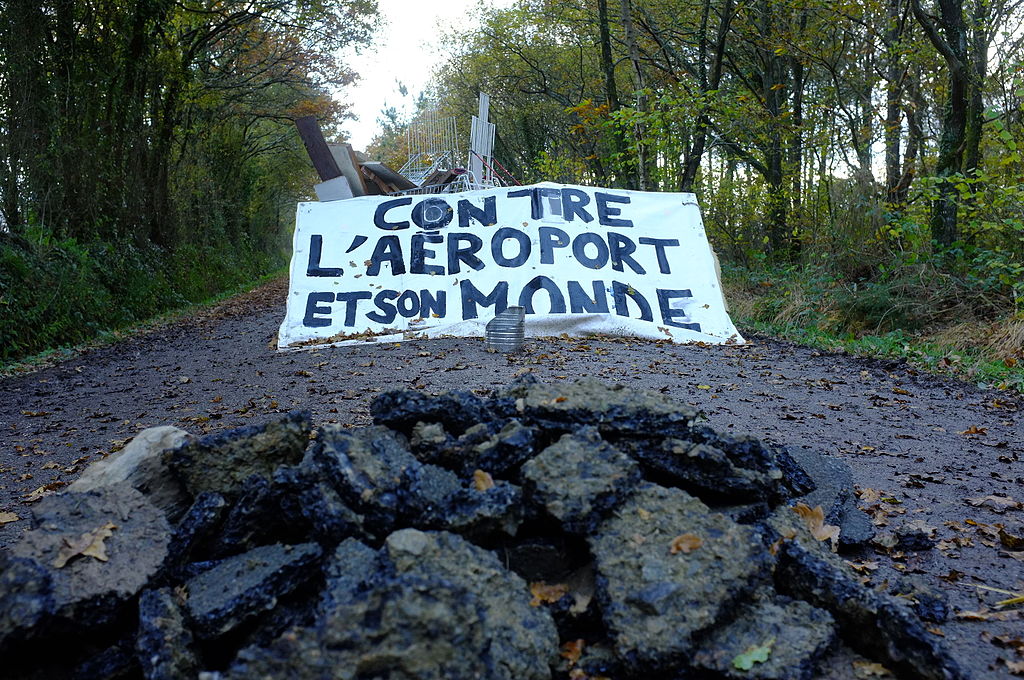
A barricade at the Notre-Dame-des-Landes ZAD. Image: Bstroot56 / source: Wikimedia Commons
Within days 20,000 people, 500 tractors and 1000 bikes blocked the main bridge of the city of Nantes. The following month 60,000 people partied on the nearby motorway, occupying exactly the point where the first bulldozers were likely to come.
Struggles are always a battle of the imagination, and these actions, like rituals and spells, raise energy and focus on a clear intention to create change: stopping the evictions.
On 8 October, when the threat of evictions peaked, 40,000 people converged from three points on the zone for a choreographed ritual, beautifully disguised as a demonstration. Much of the movement was composed of local people, farmers, no-god-no-masters anarchists and libertarian communists. Announcing a ritual would not be mobilizing, presuppositions of esotericism would be rife. The call asked people to bring a walking stick or staff.
This symbol was because one of the ancestors of the struggle, a radical peasant farmer who had recently died, used to carry a staff as a souvenir from the Larzac struggle. It was also an object that broke binaries: a staff is both a symbol of care (it helps us walk) and of conflict (it can be used to defend oneself from the police). Over 20,000 people stuck their staff deep into the earth, making a pledge that they would return to get their stick and defend the land if the government came to build the airport. ‘We are here, we will be here!’ they promised. An earthen bank was transformed into a giant porcupine bristling tens of thousands of defensive sticks.
As the sticks were being planted, in the adjoining field the huge Barn of the Future was raised. An oak, cathedral-like structure built in medieval techniques, which will last thousands of years. It signified to the authorities that this was not just a precarious protest camp with cabins, but we were here for good. The next day TV sets across the country reverberated with the prime minister’s loop: ‘The evictions will happen. There can be no other way.’ It turned out to be the last mass action of the movement against the airport. Magic doesn’t work in theory but does in practice. The government never came to build their airport. Magic doesn’t work in theory but only in practice.
Rituals of regeneration
After the victory against the airport, celebrated with a huge party where a giant newt set alight a huge wooden plane, the French government attacked the zad as an act of revenge. We not only forced the abandonment of a massive infrastructure, but for six years showed that it was possible to live collectively without police or government. There is nothing the authorities hate more. For three days 4,000 police, drones, helicopters and tanks destroyed 40 of the 70 living collectives, injuring 200 people. A ceasefire forced us into signing a legalization deal, and conflicts peaked on the zad around the risks linked to normalization, the capitulation that such a gesture represented, and the necessity to keep hold of the land and our relationships for the long term.
For the first anniversary of the abandonment on 17 January 2019, four of us formed La Cellule D’action Rituel. Faced with the trauma and conflict that had scarred the bodyminds in our community, we aimed to use the power of ritual as a tool of community care and healing. The giant newt puppet built for the party to celebrate the cancellation of the airport was brought out of storage and given a huge, red, velvet heart, broken in two. Ghostly 3m tall riot police with monstrous glowing red eyes were felled, a special song about rebirth from the ashes was sung by 200 people holding burning torches. At the climax the newt’s heart was repaired by mud masked spirits together with hundreds of folk binding it with red rope.
Newts have special cells that enable them to self-repair their hearts if damaged; it seemed a fitting metaphor for a rite of passage from one zad to the next, a ritual to come to terms with our grief together, to connect us to each other and our more than humans accomplices, who have taught us so much about how to live. The ritual ended with the lighthouse, built where they wanted to build a control tower, being switched on to the sound of Bonnie Tyler’s Total Eclipse of the Heart. The crowd danced inside the newt as it wound its way to a sumptuous banquet in a circus tent on the other side of the forest.
Ever since, la C.A.R has been designing and facilitating rituals on the zad, many mark the Eight Sabats for Witches of the Wheel of the Year (such as Equinox, Samhain, etc). We also design rituals that are needed by the community for specific functions. One ritual to get rid of our own police in our heads and judgements towards others, involved a wild game with mud and giant cell masks and ended up burning a real riot cop helmet. Several involved sigils, magic symbols to focus intention. We used them to protect the forest commons from being controlled by the forestry commission and on the new (not legal) buildings being built on the ruins of the farms destroyed in 2012 for the airport.
We don’t like the solemnity of much contemporary ritual making. Games and joy are central for us. We have had queer ecology game shows, hacked punk songs, a mister loyal drag king or erotic ecology video projections. Inspired by age old traditions whilst fabricating our own aesthetics, that we call ‘animist kitsch’, the aim of the CAR is to re-inscribe our lives in the cycle of life and seasons, and celebrate together the joy of being part of this land and all its inhabitants, whilst honouring the legacy of a unique struggle.
Rituals constitute a powerful architecture to anchor the collective by giving it strength and shared intentions as well as taking part in the elaboration of a common narrative and imagination. As Isabelle Stengers reminds us, there are no commons without ‘commoning’: commons are the fruit of relationships and practices, at their heart are customs that must be created and deployed in a culture that has almost eradicated them.
For us ritual is also the opposite of what we term ‘extractivist art’, because in ritual you are not making a performance ‘about’ a struggle, exported into an art space where value is shifted from a specific community to the art world and artist career. Ritual is by its nature reciprocal, it gives back to the land, to the community of humans and more than humans. We see so much contemporary art and performance as simply impoverished ritual, ritual without a place, gestures lacking shared meanings or community. It is culture without reference to its etymological origins – cult and terra – to cultivate and look after the earth. Culture without the cult – the reverence for life that we so need in these stormy times.
